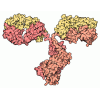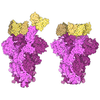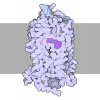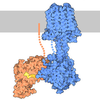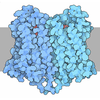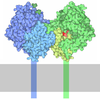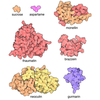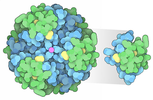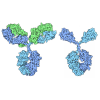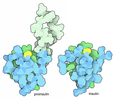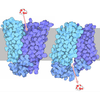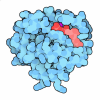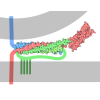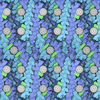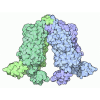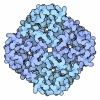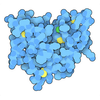+ Open data
Open data
- Basic information
Basic information
| Entry | Database: PDB / ID: 8zh8 | ||||||
|---|---|---|---|---|---|---|---|
| Title | Human GPR103 -Gq complex bound to QRFP26 | ||||||
 Components Components |
| ||||||
 Keywords Keywords | MEMBRANE PROTEIN/IMMUNE SYSTEM / GPCR / MEMBRANE PROTEIN / MEMBRANE PROTEIN-IMMUNE SYSTEM complex | ||||||
| Function / homology |  Function and homology information Function and homology informationorexigenic neuropeptide QRFP receptor binding / neuropeptide Y receptor activity / adenylate cyclase-activating serotonin receptor signaling pathway / Orexin and neuropeptides FF and QRFP bind to their respective receptors / negative regulation of adenylate cyclase-activating adrenergic receptor signaling pathway / regulation of feeding behavior / sensory perception of chemical stimulus / negative regulation of calcium ion-dependent exocytosis / grooming behavior / G protein-coupled adenosine receptor signaling pathway ...orexigenic neuropeptide QRFP receptor binding / neuropeptide Y receptor activity / adenylate cyclase-activating serotonin receptor signaling pathway / Orexin and neuropeptides FF and QRFP bind to their respective receptors / negative regulation of adenylate cyclase-activating adrenergic receptor signaling pathway / regulation of feeding behavior / sensory perception of chemical stimulus / negative regulation of calcium ion-dependent exocytosis / grooming behavior / G protein-coupled adenosine receptor signaling pathway / mu-type opioid receptor binding / positive regulation of blood pressure / corticotropin-releasing hormone receptor 1 binding / positive regulation of urine volume / negative regulation of adenylate cyclase activity / neuropeptide hormone activity / positive regulation of neural precursor cell proliferation / G-protein activation / Activation of the phototransduction cascade / Glucagon-type ligand receptors / Thromboxane signalling through TP receptor / Sensory perception of sweet, bitter, and umami (glutamate) taste / G beta:gamma signalling through PI3Kgamma / G beta:gamma signalling through CDC42 / negative regulation of synaptic transmission / Cooperation of PDCL (PhLP1) and TRiC/CCT in G-protein beta folding / Activation of G protein gated Potassium channels / Inhibition of voltage gated Ca2+ channels via Gbeta/gamma subunits / Ca2+ pathway / G alpha (z) signalling events / High laminar flow shear stress activates signaling by PIEZO1 and PECAM1:CDH5:KDR in endothelial cells / Glucagon-like Peptide-1 (GLP1) regulates insulin secretion / Vasopressin regulates renal water homeostasis via Aquaporins / Adrenaline,noradrenaline inhibits insulin secretion / ADP signalling through P2Y purinoceptor 12 / G alpha (q) signalling events / gamma-aminobutyric acid signaling pathway / G alpha (i) signalling events / beta-2 adrenergic receptor binding / Activation of G protein gated Potassium channels / G-protein activation / G beta:gamma signalling through PI3Kgamma / Prostacyclin signalling through prostacyclin receptor / G beta:gamma signalling through PLC beta / ADP signalling through P2Y purinoceptor 1 / Thromboxane signalling through TP receptor / Presynaptic function of Kainate receptors / G beta:gamma signalling through CDC42 / Inhibition of voltage gated Ca2+ channels via Gbeta/gamma subunits / G alpha (12/13) signalling events / Glucagon-type ligand receptors / G beta:gamma signalling through BTK / Thrombin signalling through proteinase activated receptors (PARs) / ADP signalling through P2Y purinoceptor 12 / Adrenaline,noradrenaline inhibits insulin secretion / Cooperation of PDCL (PhLP1) and TRiC/CCT in G-protein beta folding / Ca2+ pathway / Thrombin signalling through proteinase activated receptors (PARs) / G alpha (z) signalling events / Extra-nuclear estrogen signaling / G alpha (s) signalling events / photoreceptor outer segment membrane / G alpha (q) signalling events / G alpha (i) signalling events / spectrin binding / Glucagon-like Peptide-1 (GLP1) regulates insulin secretion / High laminar flow shear stress activates signaling by PIEZO1 and PECAM1:CDH5:KDR in endothelial cells / Vasopressin regulates renal water homeostasis via Aquaporins / neuronal dense core vesicle / alkylglycerophosphoethanolamine phosphodiesterase activity / PKA activation in glucagon signalling / regulation of calcium ion transport / negative regulation of apoptotic signaling pathway / developmental growth / photoreceptor outer segment / D1 dopamine receptor binding / neuropeptide signaling pathway / Hedgehog 'off' state / positive regulation of insulin receptor signaling pathway / Adenylate cyclase inhibitory pathway / cellular response to hormone stimulus / response to prostaglandin E / ionotropic glutamate receptor binding / adenylate cyclase regulator activity / positive regulation of vascular associated smooth muscle cell proliferation / insulin-like growth factor receptor binding / photoreceptor inner segment / cardiac muscle cell apoptotic process / response to nutrient / adenylate cyclase activator activity / hippocampal mossy fiber to CA3 synapse / positive regulation of superoxide anion generation / locomotory behavior / Regulation of insulin secretion / G protein-coupled receptor binding / G protein-coupled receptor activity / adenylate cyclase-inhibiting G protein-coupled receptor signaling pathway / bone development / G-protein beta/gamma-subunit complex binding / platelet aggregation Similarity search - Function | ||||||
| Biological species |  Homo sapiens (human) Homo sapiens (human)    | ||||||
| Method | ELECTRON MICROSCOPY / single particle reconstruction / cryo EM / Resolution: 3.19 Å | ||||||
 Authors Authors | Iwama, A. / Akasaka, H. / Sano, F.K. / Oshima, H.S. / Shihoya, W. / Nureki, O. | ||||||
| Funding support |  Japan, 1items Japan, 1items
| ||||||
 Citation Citation |  Journal: Nat Commun / Year: 2024 Journal: Nat Commun / Year: 2024Title: Structure and dynamics of the pyroglutamylated RF-amide peptide QRFP receptor GPR103. Authors: Aika Iwama / Ryoji Kise / Hiroaki Akasaka / Fumiya K Sano / Hidetaka S Oshima / Asuka Inoue / Wataru Shihoya / Osamu Nureki /  Abstract: Pyroglutamylated RF-amide peptide (QRFP) is a peptide hormone with a C-terminal RF-amide motif. QRFP selectively activates a class A G-protein-coupled receptor (GPCR) GPR103 to exert various ...Pyroglutamylated RF-amide peptide (QRFP) is a peptide hormone with a C-terminal RF-amide motif. QRFP selectively activates a class A G-protein-coupled receptor (GPCR) GPR103 to exert various physiological functions such as energy metabolism and appetite regulation. Here, we report the cryo-electron microscopy structure of the QRFP26-GPR103-G complex at 3.19 Å resolution. QRFP26 adopts an extended structure bearing no secondary structure, with its N-terminal and C-terminal sides recognized by extracellular and transmembrane domains of GPR103 respectively. This movement, reminiscent of class B1 GPCRs except for orientation and structure of the ligand, is critical for the high-affinity binding and receptor specificity of QRFP26. Mutagenesis experiments validate the functional importance of the binding mode of QRFP26 by GPR103. Structural comparisons with closely related receptors, including RY-amide peptide-recognizing GPCRs, revealed conserved and diversified peptide recognition mechanisms, providing profound insights into the biological significance of RF-amide peptides. Collectively, this study not only advances our understanding of GPCR-ligand interactions, but also paves the way for the development of novel therapeutics targeting metabolic and appetite disorders and emergency medical care. | ||||||
| History |
|
- Structure visualization
Structure visualization
| Structure viewer | Molecule:  Molmil Molmil Jmol/JSmol Jmol/JSmol |
|---|
- Downloads & links
Downloads & links
- Download
Download
| PDBx/mmCIF format |  8zh8.cif.gz 8zh8.cif.gz | 244.5 KB | Display |  PDBx/mmCIF format PDBx/mmCIF format |
|---|---|---|---|---|
| PDB format |  pdb8zh8.ent.gz pdb8zh8.ent.gz | 187.3 KB | Display |  PDB format PDB format |
| PDBx/mmJSON format |  8zh8.json.gz 8zh8.json.gz | Tree view |  PDBx/mmJSON format PDBx/mmJSON format | |
| Others |  Other downloads Other downloads |
-Validation report
| Summary document |  8zh8_validation.pdf.gz 8zh8_validation.pdf.gz | 1.1 MB | Display |  wwPDB validaton report wwPDB validaton report |
|---|---|---|---|---|
| Full document |  8zh8_full_validation.pdf.gz 8zh8_full_validation.pdf.gz | 1.1 MB | Display | |
| Data in XML |  8zh8_validation.xml.gz 8zh8_validation.xml.gz | 46.4 KB | Display | |
| Data in CIF |  8zh8_validation.cif.gz 8zh8_validation.cif.gz | 68.9 KB | Display | |
| Arichive directory |  https://data.pdbj.org/pub/pdb/validation_reports/zh/8zh8 https://data.pdbj.org/pub/pdb/validation_reports/zh/8zh8 ftp://data.pdbj.org/pub/pdb/validation_reports/zh/8zh8 ftp://data.pdbj.org/pub/pdb/validation_reports/zh/8zh8 | HTTPS FTP |
-Related structure data
| Related structure data |  60096MC M: map data used to model this data C: citing same article ( |
|---|---|
| Similar structure data | Similarity search - Function & homology  F&H Search F&H Search |
- Links
Links
- Assembly
Assembly
| Deposited unit | 
|
|---|---|
| 1 |
|
- Components
Components
-Protein , 2 types, 2 molecules RB
| #1: Protein | Mass: 45652.039 Da / Num. of mol.: 1 Source method: isolated from a genetically manipulated source Source: (gene. exp.)  Homo sapiens (human) / Gene: QRFPR, GPR103 / Cell line (production host): HEK293S GnTI- / Production host: Homo sapiens (human) / Gene: QRFPR, GPR103 / Cell line (production host): HEK293S GnTI- / Production host:  Homo sapiens (human) / References: UniProt: Q96P65 Homo sapiens (human) / References: UniProt: Q96P65 |
|---|---|
| #3: Protein | Mass: 38744.371 Da / Num. of mol.: 1 Source method: isolated from a genetically manipulated source Source: (gene. exp.)   Homo sapiens (human) / References: UniProt: P54311 Homo sapiens (human) / References: UniProt: P54311 |
-Guanine nucleotide-binding protein G(I)/G(S)/G(O) subunit gamma- ... , 2 types, 2 molecules GA
| #4: Protein | Mass: 7547.685 Da / Num. of mol.: 1 Source method: isolated from a genetically manipulated source Source: (gene. exp.)   Homo sapiens (human) / References: UniProt: P63212 Homo sapiens (human) / References: UniProt: P63212 |
|---|---|
| #5: Protein | Mass: 36573.531 Da / Num. of mol.: 1 Source method: isolated from a genetically manipulated source Source: (gene. exp.)  Homo sapiens (human) / Gene: GNG2, GNAI2, GNAI2B, GNAS, GNAS1 / Cell line (production host): HEK293S GnTI- / Production host: Homo sapiens (human) / Gene: GNG2, GNAI2, GNAI2B, GNAS, GNAS1 / Cell line (production host): HEK293S GnTI- / Production host:  Homo sapiens (human) Homo sapiens (human)References: UniProt: P59768, UniProt: P04899, UniProt: Q5JWF2 |
-Protein/peptide , 1 types, 1 molecules Q
| #7: Protein/peptide | Mass: 2835.161 Da / Num. of mol.: 1 / Source method: obtained synthetically / Source: (synth.)  Homo sapiens (human) / References: UniProt: P83859 Homo sapiens (human) / References: UniProt: P83859 |
|---|
-Antibody , 2 types, 2 molecules NS
| #2: Antibody | Mass: 15015.728 Da / Num. of mol.: 1 Source method: isolated from a genetically manipulated source Source: (gene. exp.)   |
|---|---|
| #6: Antibody | Mass: 27720.795 Da / Num. of mol.: 1 Source method: isolated from a genetically manipulated source Source: (gene. exp.)   |
-Details
| Has ligand of interest | N |
|---|---|
| Has protein modification | Y |
-Experimental details
-Experiment
| Experiment | Method: ELECTRON MICROSCOPY |
|---|---|
| EM experiment | Aggregation state: PARTICLE / 3D reconstruction method: single particle reconstruction |
- Sample preparation
Sample preparation
| Component | Name: Human GPR103 -Gq complex bound to QRFP26 / Type: COMPLEX / Entity ID: all / Source: RECOMBINANT |
|---|---|
| Source (natural) | Organism:  Homo sapiens (human) Homo sapiens (human) |
| Source (recombinant) | Organism:  Homo sapiens (human) Homo sapiens (human) |
| Buffer solution | pH: 8 |
| Specimen | Embedding applied: NO / Shadowing applied: NO / Staining applied: NO / Vitrification applied: YES |
| Vitrification | Cryogen name: ETHANE |
- Electron microscopy imaging
Electron microscopy imaging
| Experimental equipment |  Model: Titan Krios / Image courtesy: FEI Company |
|---|---|
| Microscopy | Model: FEI TITAN KRIOS |
| Electron gun | Electron source:  FIELD EMISSION GUN / Accelerating voltage: 300 kV / Illumination mode: FLOOD BEAM FIELD EMISSION GUN / Accelerating voltage: 300 kV / Illumination mode: FLOOD BEAM |
| Electron lens | Mode: BRIGHT FIELD / Nominal defocus max: 1600 nm / Nominal defocus min: 800 nm |
| Image recording | Electron dose: 0.83 e/Å2 / Film or detector model: GATAN K3 (6k x 4k) |
- Processing
Processing
| CTF correction | Type: PHASE FLIPPING AND AMPLITUDE CORRECTION |
|---|---|
| 3D reconstruction | Resolution: 3.19 Å / Resolution method: FSC 0.143 CUT-OFF / Num. of particles: 142831 / Symmetry type: POINT |
 Movie
Movie Controller
Controller



 PDBj
PDBj

